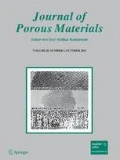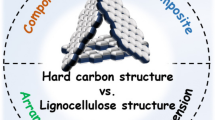Abstract
According to the idea of the circular economy, various wastes should be reasonably managed and recycled for the achievement of the carbon peak and carbon neutralization (double carbon targets). For this purpose, Mn2+ in the waste graphene production effluent was firstly extracted in the form of Mn2O3 powder by the chemical precipitation and the subsequent calcination in air for the different times of 0.5 h, 2 h and 4 h, and the resultant samples were marked as Mn2O3-0.5 h, Mn2O3-2 h, Mn2O3-4 h, respectively. The removal rate and recovery rate of Mn2+ was calculated as about 99.9% and 92.6%, respectively. Furthermore, the effect of the calcination time on the morphology, structure and Li-storage performance of Mn2O3 powder was also further investigated. The results showed that the crystallinity of Mn2O3 increased with the increase of the calcination time, while the walnut-like morphology underwent a process from the integrity to the collapse. Resultantly, 2 h was an optimal calcination time, and Mn2O3-2 h powder exhibited a porous walnut-like morphology with the mean particle size of about 1.0 μm and the largest surface area. Furthermore, Mn2O3-2 h anode delivered the best electrochemical Li-storage performances. For example, the reversible discharge capacity of Mn2O3-2 h anode was about 466 mAh/g for 100 cycles at 1.0 A/g, higher than those of Mn2O3-0.5 h anode and Mn2O3-4 h anode. Obviously, such efforts provide a new strategy for the recovery of graphene production effluent, which may promote the development of the circular economy and the achievement of the double carbon targets.










Similar content being viewed by others
References
X.Q. Zeng, M. Li, D. Abd El-Hady, W. Alshitari, A.S. Al-Bogami, J. Lu, K. Amine, Commercialization of lithium battery technologies for electric vehicles. Adv. Energ. Mater. 9(27), 1–25 (2019)
J. Baars, T. Domenech, R. Bleischwitz, H.E. Melin, O. Heidrich, Circular economy strategies for electric vehicle batteries reduce reliance on raw materials. Nat. Sustain. 4(1), 71–79 (2020)
H.S. Kristensen, M.A. Mosgaard, A review of micro level indicators for a circular economy-moving away from the three dimensions of sustainability? J. Clean. Prod. 243, 1–19 (2019)
Q.Y. Chen, Y. Yao, X.Y. Li, J. Lu, Comparison of heavy metal removals from aqueous solutions by chemical precipitation and characteristics of precipitates. J. Water Process. Eng. 26, 289–300 (2018)
W. Xiang, X.Y. Zhang, J.J. Chen, W.X. Zou, F. He, X. Hu, D.C.W. Tsang, Y.S. Ok, B. Gao, Biochar technology in wastewater treatment: a critical review. Chemosphere 52, 1–58 (2020)
A.S. Ayansina, O.O. Babalola, A New Strategy for heavy metal polluted environments: a review of microbial biosorbents. Int. J. Env. Res. Pub. He. 14(1), 1–16 (2017)
N. Sarwar, M. Imran, M.R. Shaheen, W. Ishaque, M.A. Kamran, A. Matloob, A. Rehim, S. Hussain, Phytoremediation strategies for soils contaminated with heavy metals: modifications and future perspectives. Chemosphere 171, 710–721 (2017)
E.O. Ezugbe, S. Rathilal, Membrane technologies in wastewater treatment: a review. Membranes 10(5), 89–117 (2020)
V. Khandegar, A.K. Saroha, Electrocoagulation for the treatment of textile industry effluent—a review. J. Environ. Manage. 128, 949–963 (2013)
K.W. Shen, L. Li, J.Q. Wang, Circular economy model for recycling waste resources under government participation: a case study in industrial waste water circulation in China. Techno. Econ. Dev. Eco. 26(1), 21–47 (2019)
F.L. Fu, Q. Wang, Removal of heavy metal ions from wastewaters: a review. J. Environ. Manage. 92(3), 407–418 (2011)
H.Y. Hou, J. Lan, J. Zhu, J.K. Li, Extraction of tetrahedral CuCl anode from the waste copper etchant and surface modification with graphene quantum dots. Ionics 27(10), 4383–4391 (2021)
X. Huang, X.Y. Qi, F. Boey, H. Zhang, Graphene-based composites. Chem. Soc. Rev. 41(2), 666–686 (2012)
P. Li, X. Zhen, L. Zheng, Y.Y. Wei, H.Y. Sun, Z. Li, X.L. Zhao, G. Chao, An iron-based green approach to 1-h production of single-layer graphene oxide. Nat. Commum. 6, 1–9 (2015)
J.F. Li, Y.D. Jia, R.S. Dong, R. Huang, P.D. Liu, X.Y. Li, Z.Y. Wang, G.D. Liu, Z.J. Chen, Advances in the mechanisms of plant tolerance to manganese toxicity. Int. J. Mol. Sci. 20(20), 1–15 (2019)
W.F. Wang, X.W. Cui, W.X. Chen, D.G. Lvey, Manganese oxide-based materials as electrochemical supercapacitor electrodes. Chem. Soc. Rev. 40(3), 1697–1721 (2011)
K. Zhang, X.P. Han, Z. Hu, X.L. Zhang, Z.L. Tao, Chen J, Nanostructured Mn-based oxides for electrochemical energy storage and conversion. Chem. Soc. Rev. 44(3), 699–728 (2015)
K.A. Stoerzinger, M. Risch, B.H. Han, Y. Shao-Horn, Recent insights into manganese oxides in catalyzing oxygen reduction kinetics. ACS Catal. 5(10), 6021–6031 (2015)
Y.F. Deng, L.N. Wan, Y. Xie, X.S. Qin, G.H. Chen, Recent advances in Mn-based oxides as anode materials for lithium ion batteries. RSC Adv. 4(45), 23914–23935 (2014)
F. Wang, T.F. Li, Y. Fang, Z.J. Wang, J.F. Zhu, Heterogeneous structured Mn2O3/Fe2O3 composite as anode material for high performance lithium ion batteries. J. Alloys Compd. 857, 1–29 (2020)
Y.Q. Tang, Y.C. Lu, A comparative electrochemical investigation and an effective promotion towards electrochemical performance of MnCO3 aggregates. Chem. Eng. J. 360, 553–561 (2019)
D.M. Dai, J.X. Qiu, H.Y. Hou, X.J. Wang, S.Y. Li, B.B. Cao, X.X. Zhou, D.H. Liu, B. Wang, B. Li, P2-layered Na0.5Li0.07Mn0.61Co0.16Ni0.16O2 cathode boosted Na-storage properties via rational subgroup element doping. J. Mater. Chem. A. 9(34), 18272–18279 (2021)
H.Y. Hou, W. Lei, K. Meng, J.X. Qiu, J. Zhu, The reutilization of expired waste zincgluconate for ZnO/C anode in lithium-ion battery. Surf. Innov. 8(1–2), 55–64 (2020)
Y.C. Li, Z. Xu, H.Q. Ma, A.S. Hursthouse, Removal of manganese(II) from acid mine wastewater: a review of the challenges and opportunities with special emphasis on Mn-oxidizing bacteria and microalgae. Water 11(12), 1–24 (2019)
H.W. Liu, One-pot synthesis and characterization of MnCO3 hierarchical micro/nano twin-spheres with superior lithium storage performances. J. Mater. Sci. Mater. El. 29(12), 10117–10122 (2018)
Y. Fang, Y.H. Wang, F. Wang, J.F. Zhu, 3D structured Mn2O3 synthesized using tween surfactant: influence on the morphology and oxygen reduction catalytic performance. CrystEngComm 21(3), 420–429 (2019)
S. Ruvinov, L. Wang, B. Ruan, O. Almog, G. Gilliland, E. Eisenstein, P.N. Bryan, Engineering the independent folding of the subtilisin BPN′ prodomain: analysis of two-state folding versus protein stability. Biochemistry 36(34), 10414–10421 (1997)
J. Zhang, D.G. Tang, H. Liu, H.M. Yang, Preparation of dimanganese trioxide by decomposing manganese carbonate under high temperature. Shandong Chem. Ind. 42(4), 1–4 (2013)
X.Y. Han, Y.P. Cui, H.W. Liu, Ce-doped Mn3O4 as high-performance anode material for lithium ion batteries. J. Alloys Compd. 814, 1–8 (2020)
F. Wang, B. Wang, J.X. Li, B. Wang, Y. Zhou, D.L. Wang, H.K. Liu, S.X. Dou, Prelithiation: a cucial strategy for boosting the practical application of next-generation lithium ion battery. ACS Nano 15(2), 2197–2218 (2021)
Z.C. Bai, Y.H. Zhang, Y.W. Zhang, C.L. Guo, B. Tang, D. Sun, MOFs-derived porous Mn2O3 as high-performance anode material for Li-ion battery. J. Mater. Chem. A 3(10), 5266–5269 (2015)
L.K. Zhou, X.H. Kong, M. Gao, F. Lian, B.J. Li, Z.F. Zhou, H.Q. Cao, Hydrothermal fabrication of MnCO3@rGO composite as an anode material for high-performance lithium ion batteries. Inorg. Chem. 53(17), 9228–9234 (2014)
K.W. Zeng, X.H. Li, Z.X. Wang, H.J. Guo, J.X. Wang, T. Li, W. Pan, K.M. Shih, Cave-embedded porous Mn2O3 hollow microsphere as anode material for lithium ion batteries. Electrochim. Acta. 247, 795–802 (2017)
L. Bigiani, C. Maccato, G. Carraro, A. Gasparotto, C. Sada, E. Comoni, D. Barreca, Tailoring vapor phase fabrication of Mn3O4 nanosystems: from synthesis to gas sensing applications. ACS Appl. Nano Mater. 1(6), 2962–2970 (2018)
S. Nagamuthu, K.S. Ryu, MOF-derived microstructural interconnected network porous Mn2O3/C as negative electrode material for asymmetric supercapacitor device. CrystEngComm 21(9), 1442–1451 (2019)
X.Q. Chen, H.B. Lin, X.W. Zheng, X. Cai, P. Xia, Y.M. Zhu, X.P. Li, W.S. Li, Fabrication of core-shell porous nanocubic Mn2O3@TiO2 as a high-performance anode for lithium ion batteries. J. Mater. Chem. A. 3(35), 18198–18206 (2015)
S.M. Li, B. Li, Y.T. Zhong, Z.H. Pan, M.Q. Xu, Y.C. Qiu, Q.M. Huang, S.W. Li, Mn2O3@C yolk-shell nanocubes as lithium-storage anode with suppressed surface electrolyte decomposition. Mater. Chem. Phys. 222, 256–262 (2019)
Y.J. Zhang, Y. Yan, X.Y. Wang, G. Li, D.R. Deng, L. Jiang, C.Y. Shu, C.R. Wang, Facile synthesis of porous Mn2O3 nanoplates and their electrochemical behavior as anode materials for lithium ion batteries. Chem. Eur. J. 20(20), 6126–6130 (2013)
S.Z. Huang, J. Jin, Y. Cai, Y. Li, Z. Deng, J.Y. Zeng, C. Wang, T. Hasan, B.L. Su, Three-dimensional (3D) bicontinuous hierarchically porous Mn2O3 single crystals for high performance lithium-ion batteries. Sci. Rep. 5(1), 1–12 (2014)
X.G. Han, X. Han, R. Li, L.Q. Sun, K. Lu, M.Y. Wu, Y.X. Wu, Y.X. Zhu, X.S. Zhao, Porous Mn2O3 microcubes with exposed 001 facets as electrode for lithium ion batteries. New J. Chem. 40(7), 6030–6035 (2016)
J. Lan, H.Y. Hou, K. Meng, M.M. Feng, J.K. Li, The recovery of expired ferrous gluconate and spent Li foils into high performance straw-bundle-like α-LiFeO2/C cathode. Electrochim. Acta 390, 1–10 (2021)
J.J. Chen, K. Yang, H.Y. Yu, T. Shah, Q.Y. Zhang, B.L. Zhang, Highly monodisperse dumbbell-like yolk-shell manganese monoxide/carbon microspheres for lithium storage and their lithiation evolution. Carbon 170, 37–48 (2020)
Y.Z. Liu, Z.H. Yang, Intercalation of sulfate anions into a Zn-Al layered double hydroxide: their synthesis and application in Zn-Ni secondary batteries. RSC Adv. 6(73), 68584–68591 (2016)
Y.C. Zhang, J.T. Li, Z.G. Wu, L. Huang, S.G. Sun, Synthesis of hierarchical spindle-like Mn2O3 for lithium ion batteries with enhanced lithium storage properties. J. Alloys Compd. 721, 229–235 (2017)
Acknowledgements
This work was financially supported the 19th Young Academic and Technical Leaders of Yunnan Province (1097-10978240).
Author information
Authors and Affiliations
Corresponding author
Additional information
Publisher's Note
Springer Nature remains neutral with regard to jurisdictional claims in published maps and institutional affiliations.
Rights and permissions
About this article
Cite this article
Hou, H., Li, J., Lan, J. et al. Porous walnut-like Mn2O3 anode derived from the waste graphene production effluent. J Porous Mater 29, 837–847 (2022). https://doi.org/10.1007/s10934-022-01216-2
Accepted:
Published:
Issue Date:
DOI: https://doi.org/10.1007/s10934-022-01216-2




